Cultivation of Potentilla
After planting, the soil is mulched with a layer of peat of 3–5 cm, then the moisture will stay in the ground longer. When planting and in spring, a complex mineral fertilizer is added, about 150 g per m². Before blooming the buds, they are fed with phosphorus and potassium.
The plant can stand for a long time without watering, but it does not like dry air. Therefore, it is advised to water the cinquefoil 3 times per season in heat and drought and spray it in the evening. Pour 10-12 liters under each bush.
Potentilla is loosened to a depth of 5-10 cm.
For more information about the care and cultivation of Potentilla, read below.
From mid-April, once every 3-4 years, shoots are cut by 10 cm, and in September they are cut off by 1/3 shoots. In the spring, shoots are pruned if their ends are frozen over the winter.
Cinquefoil is quite resistant to pests and diseases, but it can get sick with rust. Then it must be sprayed with zineb (0.4%) or copper-soap liquid.
Cinquefoil Pink Beauty in the landscape
Easily tolerates haircuts, retaining a decorative look for a long time, therefore Pink Beauty is most often used to create both free-growing and trimmed borders and hedges. In combination with herbaceous perennial plants, it is used to create rockeries, rocky gardens, rabatok and rock gardens.
-
Latin name:
Potentilla fruticosa Pink Beauty
-
Crown diameter and height in the middle lane:
has a height of no more than 0.5 m
-
Bloom:
large flowers of deep pink color give the shrub a special picturesque
-
Foliage:
dense foliage of small pinnately dissected emerald leaves forms a hemispherical crown up to 0.8 m wide with separately protruding branches. Leaves turn yellowish brown in autumn
-
Growth and cultivation features:
has a high drought, gas and smoke resistance
-
The soil:
prefers fertile and well-moisturized soils
-
Light:
light-loving plant, but grows without any problems in shaded areas
-
Frost resistance:
winter-hardy plant
-
Landing:
the soil in the planting pits should be well enriched with humus and mineral fertilizers. Broken brick or pebbles (up to 20 cm) are suitable for a drainage device
-
Crown structure:
reddish brown
Pink beauty shrub
considered the best among pink-flowering Potentilla. It is a very beautiful, decorative variety, with a rather unusual, pure and bright pink color. The shrub itself is about eighty centimeters tall, and slightly more "wide", that is, diameter. The foliage color of this variety is bright green, saturated. The diameter of the flowers is about three centimeters, and in this variety, the flowers do not fade in the sun. Closer to autumn, the color of the flowers becomes more saturated. Pink beauty blooms just like most varieties, from summer to frost. The difference from other varieties is not only in color, but also in the arrangement of flowers - they are strictly solitary, and not collected in inflorescences.
Pink beauty grade
which is very popular with gardeners. It is used for hedges and borders, and as an independent ornamental shrub.
Growing Potentilla Pink Beauty
does not represent anything difficult.
- a plant for lazy florists. It just needs to be planted in the right place (sunny or semi-darkened), at the right distance (free space, about forty centimeters in radius), and in the right soil (loose, fertile and moist).
Pink beauty tolerates winter as well as less decorative varieties of Potentilla.
Cinquefoil pink beauty care
This variety is a typical representative of the species. Top dressing twice a year, watering three times and pruning once. That's actually the whole pink beauty care
.
You need to feed it with mineral fertilizers in early spring. And right before the bush blooms, potash-phosphorus fertilizers are applied.
Potentilla is watered in the evening, rarely, but abundantly. In addition to watering, you can spray the crown with water, Potentilla likes the humidity to be increased.
Trim pink beauty
you need either early spring or very late autumn. Most often, spring pruning is carried out. Moreover, the purpose of pruning is not only to remove old branches and shorten young ones, but also to form a crown. The bush can be shaped in different ways, it all depends on your desire.
Cinquefoil pink beauty reproduction
All Potentilla is propagated either vegetatively or by seeds.
Seed propagation is quite simple - the collected seeds are sown in the greenhouse in spring.
And cuttings are planted both in spring and in autumn. The most important thing is that the plant has time to take root, it takes at least a month.
Cuttings are first planted in a greenhouse, and after a year they select a suitable place on the site.
Popular varieties of Potentilla for growing in the garden:
- loves well-lit sunny places and dry loose soils.
- prefers moist, light and fertile.
- loves sunny places, but can grow with a little shade.
Cinquefoil, description and types of plants
Cinquefoil is a plant represented by numerous types of annual, biennial, perennial crops, among which there are both shrub and herbaceous species.
Shrub cinquefoil. Perennial shrub with a dense spherical crown. The height of the shrub reaches up to 1.5 meters. This is the most common type of the genus, which is popularly called "Kuril tea" or "five-leafed leaf". In nature, compact, highly branched bushes can often be found on rocky slopes, talus, in cracks in rocks on pebbles, where they form thickets. The leaves of Potentilla shrub are slightly pubescent, dissected into 5 lobes, the flowers are rather large, collected in inflorescences. There are many stamens in the center of the flower, which makes its middle look fluffy.

The beginning of flowering of shrubby Potentilla in June, lasts until October. There are shrubs with different colors of flowers, but most often the flowering of Potentilla shrub resembles the flowering of an apple or rose hip. After flowering, an achene is formed - a box in the form of a brown button, which gives an additional decorative effect to the culture.
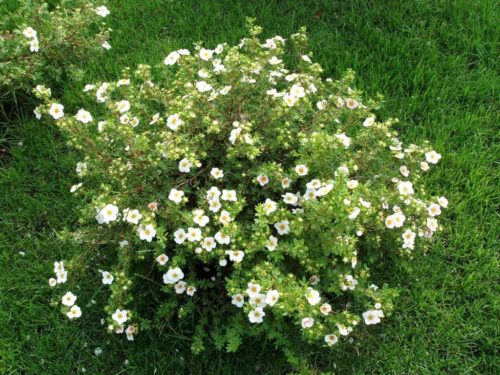
Among the most popular varieties are:
- Abbotswood is a bush, up to 1 meter high, with a dense pillow-like crown. The leaves are light green, white flowers are collected in small clusters. The shrub looks great in rock gardens, in group plantings with other plants, and is used to decorate borders.
- Guildford Cream is a tall bush, up to 1.5 in height. The crown is dense, cushion-shaped, the leaves have a dark green tint. The flowers are large, creamy or white.
- Red Ace - Shrub up to 70 cm high, wide crown - up to 1.3 meters wide. A feature of the variety is creeping shoots. The leaves are dark green, blooms with bright flowers in orange-red tones.
- Pink Queen is a flowering shrub up to 80 cm high, blooms with delicate pink flowers, flowering time from June to September.
- Hoppy Orange is a low bush up to 0.5 meters in height with a wide one meter crown. One of the most hardy and winter-hardy varieties.
Apennine cinquefoil. A perennial plant native to the mountainous part of Europe, where it grows at an altitude of over 1,500 meters. Plant height from 5 to 15 cm, leaves are trifoliate, pubescent, with a silvery shade. It blooms with pink or white flowers, up to 15 mm in diameter, flowering time - late summer. Used to decorate rock gardens, stone crevices in landscape design.

White bloodroot. A perennial plant native to central Europe and Russia. Height from 8 to 25 cm. Stems and leaves are covered with silky, adpressed hairs. It has complex basal leaves, palmate-lobed with dark brown stipules. It blooms with small white flowers on long stalks, up to 3 cm in diameter, from May to August. An unpretentious culture, however, it does not tolerate scorching sunlight and an excess of moisture in the soil.
 Cinquefoil goose, or goose foot.Ground cover, unpretentious culture, widespread in Russia. The leaves are pinnate, large-toothed, blooms with small yellow single flowers, up to 2 cm in diameter. Peduncles are leafless. The plant is not demanding, it grows everywhere, along roads, highways - where other plants will not survive.
Cinquefoil goose, or goose foot.Ground cover, unpretentious culture, widespread in Russia. The leaves are pinnate, large-toothed, blooms with small yellow single flowers, up to 2 cm in diameter. Peduncles are leafless. The plant is not demanding, it grows everywhere, along roads, highways - where other plants will not survive.
Nepalese cinquefoil. Perennial herbaceous species, bush height up to half a meter. Nepal and the Western Himalayas are considered his homeland. Stems - straight, branched, purple-tinged. The leaves of this variety are rather large, palmate, up to 30 cm long, dark green in color. The flowers are bright, large, red, pink, with dark pink veins, gathered in panicles. The beginning of flowering is July, duration is 55 days. 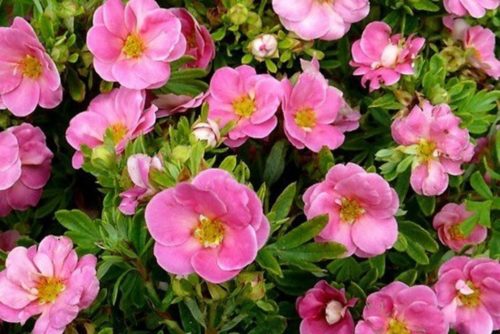
Among the Nepalese Potentilla there are attractive hybrid varieties, the most common of which are:
- Miss Wilmott - lush cherry pink flowers with a dark eye.
- Roxana - salmon-orange flowers with thin dark veins.

Erect cinquefoil (straight, or galangal). Perennial with thickened woody rhizome, grows in the wild in forests, tundra, on the banks of rivers, lakes, swamps. The stem of the plant is erect, up to 20 cm high, the upper part of the bush is without foliage. The flowers are single, regular, up to 1 cm in diameter, growing on long thin pedicels. The flowering period is June - August.
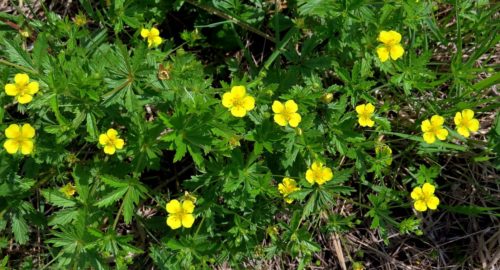
Species diversity. The best varieties
Potentilla types are conventionally divided into three groups, differing in flower color:
- yellow-flowered;
- white-flowered;
- red-flowered (this includes species with pink, orange and red petals).
Each group has a huge number of varieties. Among the whole variety of shrub varieties, it is worth highlighting several of the most popular:
Goldfinger.
One of the brightest representatives of the yellow-flowered group is the Goldfinger Potentilla. The shoots of the shrub grow up to 1.2 m, the crown of an adult bush reaches 1.5 m in diameter, and the dark yellow flowers are 4-5 cm. The plant blooms from June until frost, and is highly resistant to diseases and pests. In landscape design, Goldfinger shrub cinquefoil is used as decorative hedges and borders, and looks great as a specimen plant.
Goldstar.
From yellow-flowered plants, the cinquefoil shrub Goldstar is distinguished. A small shrub with a height of 0.6-0.7 m in June is covered with large golden-yellow flowers (up to 5 cm in diameter). Abundant flowering continues until the first frost.
Abbotswood.
Shrub cinquefoil Abbotswood belongs to the group of white-flowered species. This is a short shrub up to 1-1.2 m high. The size of white flowers is small and is 2.0-2.5 cm in diameter, but a large number of simultaneously opened petals and long flowering from June to September make this variety the best of the group.
Red Ice.
From the representatives of the third group, the Red Ice shrub cinquefoil stands out. The plant blooms for almost three months, while the color of the petals changes throughout the season: at the beginning of summer, orange-red flowers bloom, in the middle of the season they turn yellow-orange, and with cold snaps they acquire a rich red color. The shrub, in comparison with the above-mentioned varieties, is not so high - the length of the stems is 0.6-0.7 m, and the diameter of the crown grows to 1.2 m.
Lovely Pink.
It is impossible to ignore another variety - cinquefoil shrub Lovely Pink (Pink Beauty), bred by breeders of Great Britain. The plant justifies its belonging to the Rosaceae family - its large bright pink flowers up to 5 cm in diameter abundantly cover a relatively low (0.5-0.6 m) bush
Despite the high decorativeness, Lovely Pink tolerates the conditions of the metropolis, drought and frost well. These qualities make it indispensable for decorating urban landscapes as a tapeworm or hedge.Gardeners plant shrubs in rabatki, rock gardens, in combination with perennials, and even use it as a ground cover plant.
Princesses.
Cinquefoil Princess in adulthood reaches 0.6-0.8 m. The shrub is covered with light pink flowers with a yellow center, atypical for other plant species. The diameter of the flowers does not exceed 3 cm. Flowering lasts from May to November, depending on the climatic conditions of the growing area.
Mango tango.
From the variety of species, the cinquefoil shrub Mango-tango stands out - a low shrub (0.5-0.6 m) with spectacular large mango-colored flowers. In cool weather, the red-orange flowers take on a rich red hue.
A wonderful decoration of the garden is the hybrid cinquefoil, bred by breeders by crossing different species. Its large double flowers can be of all kinds of shades: yellow, pink, red and purple.
The garden shrub cinquefoil is unpretentious and at the same time decorative, planting and caring for which does not cause any particular problems, regardless of the variety. This is how she earned the love of lovers of flowering plants and landscape designers.
Pests and diseases
When creating breeding varieties, in addition to frost resistance, attention is paid to the ability to resist infection. Cinquefoil Lovely Pink rarely gets sick, powdery mildew is the only fungal infection that threatens the culture
Disease appears with high humidity. When the first signs are detected, the cinquefoil is treated with Bordeaux liquid.
In case of mass distribution of moths, caterpillars can be found on the leaves. Get rid of the pest with "Zolon". This problem occurs in temperate climates. In the South, with low humidity and abnormally high temperatures, the appearance of a spider mite is noted. The Sunmight treatment shows a good result.
Cinquefoil - reproduction
Like all garden plants, Potentilla is propagated by seeds or vegetatively.
Propagation of Potentilla by seeds
The seed method of planting Potentilla is used less often than the vegetative one and is only possible for experienced flower growers who prefer to sow seeds directly into the ground. However, for good germination, it is recommended to sow seeds indoors using containers. Sowing seeds in containers is carried out in the last decade of February. For planting, a wide box with drainage holes is prepared, which is filled with a nutritious soil mixture. You can use peat and humus, taken in the same proportion. Seeds are planted in moist soil, sprinkled with a small layer of earth, and covered with transparent glass or film. The optimum temperature for seedling germination is - + 16-18 ° C. It should be noted that some varieties of Potentilla reproduce by self-seeding.
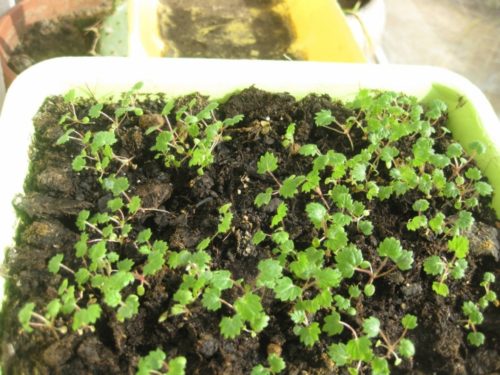
Propagation of Potentilla by cuttings
Cuttings are made in July or August. For propagation by cuttings, last year's shoots are chosen, from which leaves and flowers are removed, the length of the cutting is from 8 to 10 cm. You can root the cutting in wet perlite or in open ground, choosing a shaded and draft-protected place in the garden for it. It is imperative to cover the stalk with a jar or plastic bottle, creating greenhouse conditions for it, not forgetting that the stalk must be sprayed and ventilated several times a day. When buds appear on the cutting, they should be removed so that they do not weaken the rooting cutting. In winter, young plants need shelter.
Reproduction of Potentilla by layering
Reproduction by layering is the simplest method of propagation of Potentilla. In the spring, select a low-growing shoot of the plant, make an incision along its outer side and place it in a small, pre-dug groove. The cut should be at the bottom of the groove, attach the shoot to the ground with a metal bracket and sprinkle with soil.By the fall, the cuttings form a strong root system and it can be separated from the mother bush by transplanting it to a permanent place.
Reproduction of Potentilla by dividing the bush
Adult shrubs are propagated by dividing, the age of the mother bush must reach 4 years. The bush is dug up, its rhizome is washed with warm water and the root is cut into pieces using a sharp knife. Each part of the cut should have 2-3 buds. The roots of the cut are processed in a growth stimulator and transplanted into the ground, without burying the buds in the ground. The method of reproduction by dividing the mother bush is used in the spring, in April or in September.
Plant propagation methods
Cinquefoil reproduces both by seed and vegetative methods. The latter is the simplest and most effective, since the cultivation of Potentilla from seeds is troublesome, in which it is impossible to preserve varietal qualities.
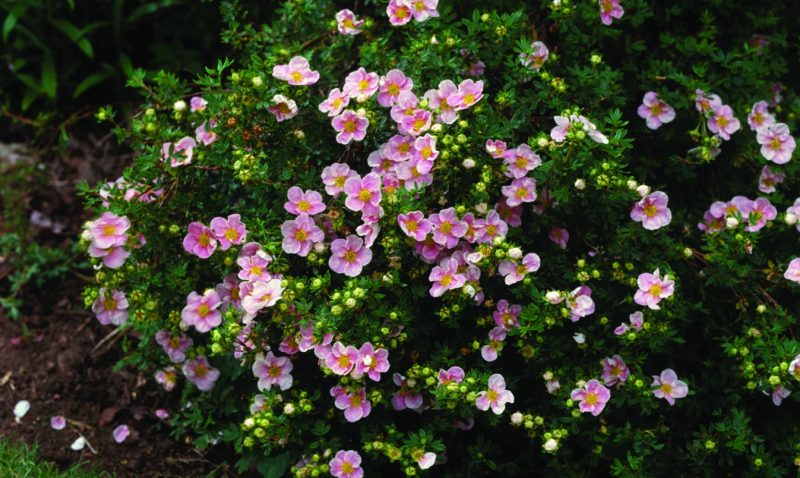
- Cuttings - in a mid-summer procedure, cuttings 10 cm long are prepared, planted in the shady area of the garden and covered with a glass jar for rooting. After 1.5 months, new plants are planted in a permanent place, and with the arrival of cold weather they are covered with spruce branches.
- Reproduction by layering is the simplest technique in which a low-growing shoot is incised along and placed in a groove up to 15 cm deep.After the formation of the roots, the layering is separated from the parent specimen and planted in the chosen place.
- Dividing the bush - during the procedure in spring or autumn, a four-year-old bush is dug up, the rhizome of which is divided into parts with three buds. The division is carried out with a sterile instrument, and the cut sites are necessarily treated with a disinfectant in the form of charcoal, activated carbon or a fungicidal preparation.
Planting and caring for pink Queen shrub cinquefoil
The Pink Queen shrub does not make great demands on the planting site, it is extremely hardy, frost-hardy and does not need special care.
As with the cultivation of shrub Potentilla of other varieties, caring for the Pink Queen variety consists in regular watering, loosening, feeding, pruning and creating conditions for a comfortable winter.
Recommended timing
Like other horticultural crops, Pink Queen is planted in spring or autumn. If it is not possible to plant seedlings with open roots immediately after purchase, they are temporarily added dropwise or the roots are placed in a plastic bag to retain moisture.
Potentilla seedlings Pink Queen with an earthy clod can be rooted throughout the season.
Shrub propagation by layering and cuttings is carried out in the second half of summer; division of the bush and sowing of seeds is carried out in the spring or autumn.
Site selection and soil preparation
It is best to plant Pink Queen cinquefoil in areas illuminated by the sun in the morning and evening hours, but it also tolerates partial shade well. In the bright sun, the petals lose their rich color, and in shady places, the quality of flowering deteriorates noticeably.
Loose, moist, well-drained substrates are most suitable for Pink Queen Potentilla. If possible, it is better to choose a site with slightly acidic soil, although the shrub can grow on almost any soil.
Attention! On alkaline soils, the leaves of Pink Queen Potentilla turn yellow.
The site for planting is dug up, plant residues are removed and leveled. Nutrient soil for filling planting pits is prepared from leafy soil, river sand and humus. It will not be superfluous to enrich the mixture with a complex of mineral fertilizers.
Landing algorithm
When planting several plants, a distance of 50-80 cm is provided between them.
Pink Queen Potentilla seedlings are rooted as follows:
- dig planting holes with a volume of 2 times larger than the volume of the root ball;
- drainage is poured to the bottom and half filled with a nutrient mixture;
- the root collar is placed flush with the ground and the seedling is covered with the remaining soil;
- the seedlings are watered, the soil around is mulched with natural materials.
It is better to purchase Potentilla seedlings in a container, so the risk of damaging the root system will be minimal.
Watering and feeding schedule
The drought resistance of Pink Queen's Potentilla allows it to do without water for some time, but it is advisable to prevent the soil from drying out. The optimal frequency of watering for adult plants is 1 time in 14 days, for young plants every other day. It is recommended to use settled water for irrigation.
To improve the quality of the soil in spring and autumn, compost is applied under the bushes. In order for the flowering of Potentilla to be abundant and long, during the season, about once a month, the soil is fertilized with a mixture of manure with ash, vermicompost or special complex preparations for flowers.
Pruning
Pruning is a mandatory procedure necessary to preserve the decorative appearance of Potentilla. Once every 2–3 years, during spring shearing, the shoots are shortened, giving the crown the shape of a ball. In addition to formative pruning, the plant needs to remove broken and damaged branches, as well as weak shoots growing deeper into the crown.
Adult plants need rejuvenation - up to 30% of old branches are removed once a season, which over time will lead to a complete renewal of the bush.
How to prepare for winter
Although the Pink Queen cinquefoil is a frost-resistant crop, in some cases it needs shelter for the winter. Plants cultivated in the northern regions, as well as young bushes planted in the current season, must be insulated.
Shelter of Pink Queen Potentilla is performed according to the following algorithm:
- the bush is huddled, the lower branches are covered with a layer of earth;
- the ground around the trunk is mulched;
- the plant is covered with spruce branches or other material.
Attention! The covering material must be breathable so that the bush is not deflated during thaws.
In the middle lane, healthy adult plants do not need insulation. Preparing them for winter consists in abundant pre-winter watering and harvesting plant residues around the plantings.
Without shelter, young plants can freeze the tips of the shoots, but thanks to the excellent ability of Potentilla to regenerate, they quickly recover after sanitary pruning. With age, the winter hardiness of the shrub increases.
Description of the plant
Shrub cinquefoil (Potentilla fruticosa) or Kuril shrub tea is a plant that has long been cultivated and grown in nurseries as a decorating tree and shrub. Recently, it has been used for the manufacture of drinks and as a medicinal raw material.
Cinquefoil is a perennial very strongly branched shrub up to 1 m in height, with processes of a reddish-brown tone and golden-yellowish flowers of the family Rosaceae. Leaves are pinnate, which consist of 5 (3–7) longish-oval leaves, emerald on top, loosely pubescent, silky below. Flowers of golden color, large, up to 3 cm, single or in small cyst-like or corymbose pleochasias. The fruits are numerous dried nuts. Flowering lasts from late June to late September.
Frost-resistant type and able to grow in areas where permafrost is permanent. Undemanding to the ground. It grows in the bosom of nature in thinned fir and deciduous forests, on cliffs, in subalpine and alpine fields. In natural locations, plantings grow rather slowly and by the age of 20 the height of the bushes is no more than 30 cm. When cultivated in summer cottages, Kuril shrub tea can reach a height of 70–90 cm by the age of 4–5 years.
Kuril tea is also revered as a beautiful plant. It is a flowering shrub with a long flowering time. Easily withstands decorative haircuts and is practically not affected by diseases and parasites. There are modifications and varieties with the largest flowers of snow-white, salmon, orange colors.
Planting and leaving
The unpretentious Kuril tea is undemanding to the composition of the soil, but loves loose soil.Before planting, the soil is carefully dug up, fertilized with a small amount of lime. Shrub cinquefoil can be planted both in open sunny places and in light shade. In the planting hole, it is necessary to create a drainage from gravel or use expanded clay for the same purpose.


Landing rules
Lovely pink seedlings take root after the snow melts, in early spring. The hole should be twice the size of the root volume of a young bush. You need to be careful with the cinquefoil rhizome, so as not to damage it during transportation to a new place of growth. A distance of 30 cm is chosen between the seedlings, and even better - 50.
Humus, leafy soil and sand are added to the ground left after digging the planting hole in a ratio of 2: 2: 1. Complex mineral fertilizers in the amount of 150 g will be useful. At the bottom of each planting hole, drainage is laid out in a thin layer, sprinkled on top of it in a small amount prepared soil mixture.
The seedling is placed in the center of the planting hole so that its root collar is above the soil level. The rhizome to the top of the planting pit is covered with soil mixture, which is then tamped.
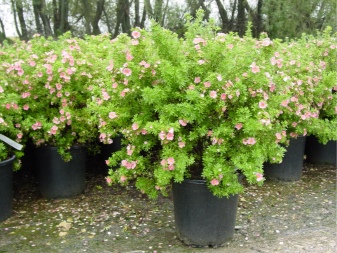
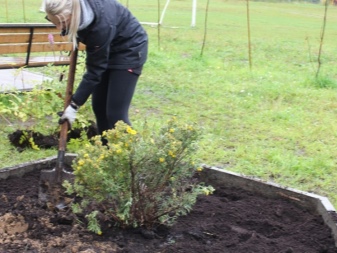
Watering
A month after planting, watering is carried out 2 times a month. It is imperative to water the pink beauty during a prolonged summer drought. In the spring and autumn period, Pink Beauty Potentilla does not need frequent watering.
Water it with warm water after sunset. One bush will need 10 liters of water. After watering, large sawdust or chips are poured into the area of the trunk circle.


Top dressing
As soon as the snow melts from the ground and it warms up, it is important to apply some kind of complex fertilizer designed to feed flowering shrubs under the root of Kuril tea. It must contain nitrogen.
In the summer, the shrub also needs to be fed once with phosphorus fertilizers, and in the fall you will need to fertilize with potassium. Instead of mineral fertilizers, organic fertilizers can be used. The shrub is fed three times a year.

Pruning
For a beautiful crown formation "Pink Beauty" and to stimulate flowering in spring, the shrub is cut off. Processing is carried out from April to May. First, they get rid of dry and damaged shoots, and then long and weak ones.
Preparation for wintering
Only a seedling of the first year of life will not tolerate wintering well. At the end of October, it is watered and covered with a thick layer of mulch in the area around the trunk. Shoots and leaves are treated with Bordeaux liquid. The procedure is aimed at preventing the development of fungal diseases under the pressure of the snow. Then you can collect the branches in a bunch and wrap them up with some covering material. Adult plants "Lovely Pink" are not afraid of frosts up to 30'C and they do not need preparation for wintering.




